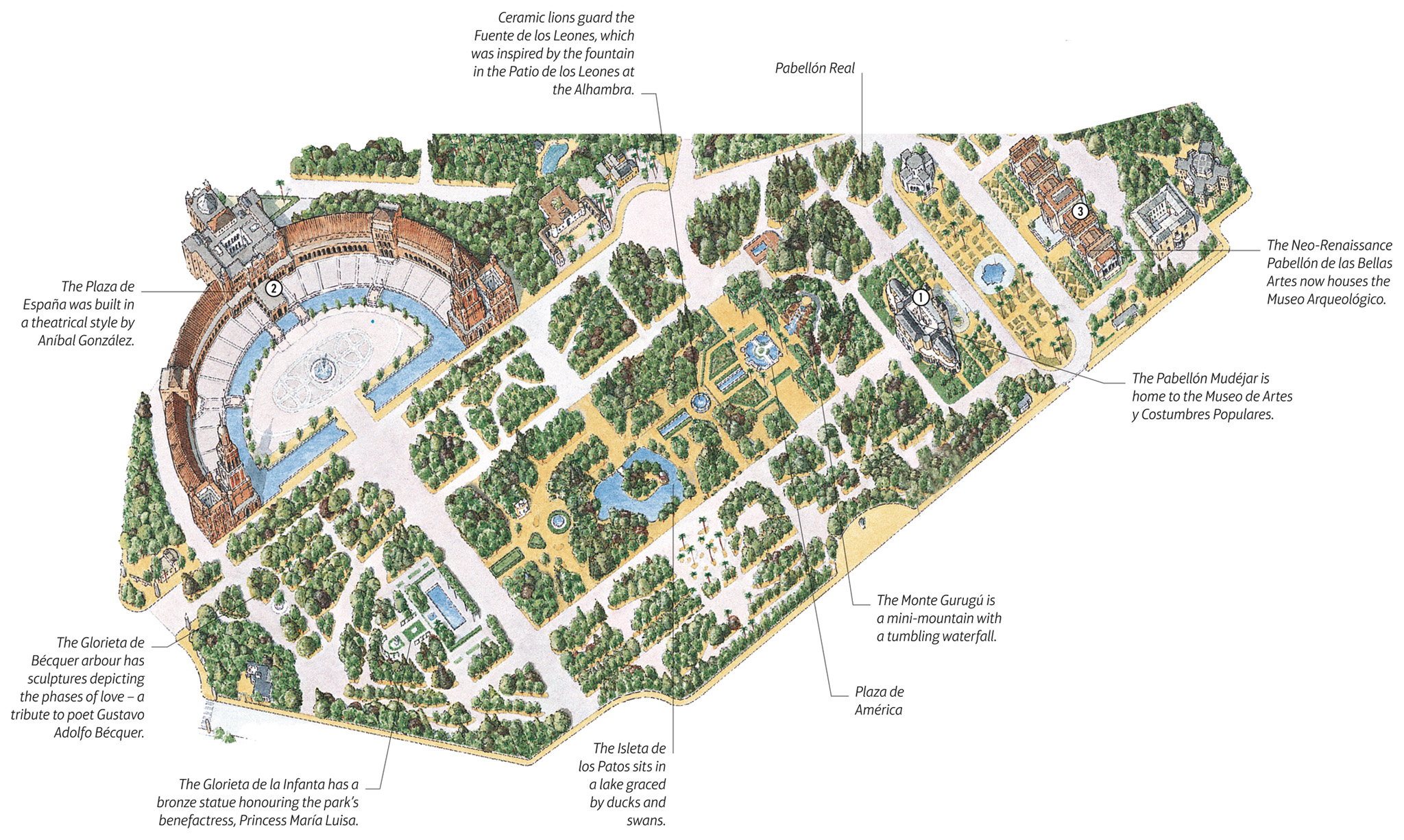
t The curving Plaza de España
Sprinkling fountains, blooming flowers and cool, tree-shaded avenues all help to make Parque María Luisa a refreshing retreat from the heat and dust of the city, particularly in summer.

t The curving Plaza de España
Experience Parque maría Luisa

t The tree-shaded avenues and pavilions that make up the Parque María Luisa
Princess María Luisa donated part of the grounds of the Palacio de San Telmo to the city for this park in 1893. Landscaped by Jean Forestier, director of the Bois de Boulogne in Paris, the park was the leafy setting for the 1929 Ibero-American Exposition. The legacies of this extravaganza are the Plaza de España, decorated with regional scenes on ceramic tiles, and the Plaza de América, both the work of architect Aníbal González. On the latter, in the Pabellón Mudéjar, the Museo de Artes y Costumbres Populares displays traditional Andalucían folk arts. The Neo-Renaissance Pabellón de las Bellas Artes houses the Museo Arqueológico, exhibiting artifacts from Itálica.
Princess María Luisa married 17-year-old Leopold II at the age of 14.
Housed in the Mudéjar Pavilion of the 1929 Ibero-American Exposition, this museum is devoted to the popular arts and traditions of Andalucía. Exhibits include workshop scenes detailing crafts such as leatherwork, goldsmithing and cooperage, with a re-creation of a Huelva wine cellar. Alongside collections of antique glassware and ceramics, both domestic and ornamental, there is also an informative account of the history of the azulejo. Upstairs is a display of 19th-century costumes, furniture, musical instruments and rural machinery. Romantic images of flamenco, bullfighting and the Semana Santa and Feria de Abril are a compendium of the Sevillian cliché.
Experience Parque María Luisa
|
EAT La Casa del Estanque International cuisine is accompanied by cocktails at this eatery. ⌂ Calle San Fernando 2 ∑ lacasadelestanque.com ¡¡¡ DRINK Terraza Bilindo This bar is found near the Plaza de América. ⌂ Paseo de las Delicias ∑ terrazabilindo.com Teterias al Sultan A sumptuous North African teahouse. ⌂ Calle San Fernando 7 ∑ teteriasensevilla.es |

t The Plaza de España’s arcade
This impressive semicircular plaza was designed by architect Aníbal González as the centrepiece for the 1929 Ibero-American Exposition. González mixed elements of Art Deco, Renaissance and Baroque Revival and Neo-Mudéjar in his design for the building fronting the plaza. With its north and south towers, it’s a major city landmark.
In the colonnade fronting the building, there are a series of alcoves decorated with stunning tiles, each representing a Spanish province and a moment in history. For example, the Barcelona alcove depicts Columbus being greeted by the Catholic Monarchs (Queen Isabel I of Castile and King Fernando II of Aragon) on his return from the New World. He bows to his king and queen while the indigenous people that he brought back with him from the Caribbean lay gifts at their feet. The Madrid alcove, meanwhile, depicts the city’s resistance to Napoleon’s troops during the Peninsular War. Each alcove is flanked by a pair of bookshelves. Here, you’ll find tomes about the province, as well as books left by other visitors. Spend some time browsing the titles.
A canal follows the curve of the building’s façade and is crossed by colourful footbridges, which represent the four ancient kingdoms of Spain – Castile, León, Aragon and Navarre. For a fee, you can jump aboard one of the boats that travel up and down this canal. It’s a wonderful way to experience the grandeur of the main building and the atmosphere of the square itself. It’ll come as no surprise that the Plaza de España has starred in many films, including Lawrence of Arabia (1962), Star Wars II: Attack of the Clones (2002) and The Dictator (2012).

t One of the tiled alcoves

PICTURE PERFECT
The Plaza de España appears as the royal plaza on planet Naboo in Star Wars II: Attack of the Clones. Make like Princess Padmé and Anakin Skywalker and snap yourselves strolling the arcades.
Designed by González, the Pabellón del Renacimiento (Renaissance Pavilion) of the 1929 Ibero-American Exposition is now Andalucía’s museum of archaeology. The basement houses Paleolithic to early-Roman exhibits, such as copies of the remarkable Tartessian Carambolo treasures. This hoard of 6th-century BC gold jewellery was discovered by a workman who was excavating a site for a new sports club near Seville in 1958. Oriental elements in its design have intrigued scholars of early civilizations.
Upstairs, the galleries are devoted to the Roman era, with statues and fragments rescued from Itálica. Highlights include a 3rd-century BC mosaic from Écija, a statue of the Venus of Itálica and sculptures of emperors Trajan and Hadrian. The rooms continue to Moorish Spain via Palaeo-Christian sarcophagi, Visigothic relics and artifacts from Medina Azahara.

t Bust of the emperor Hadrian, born in Itálica, in the Museo Arqueológico